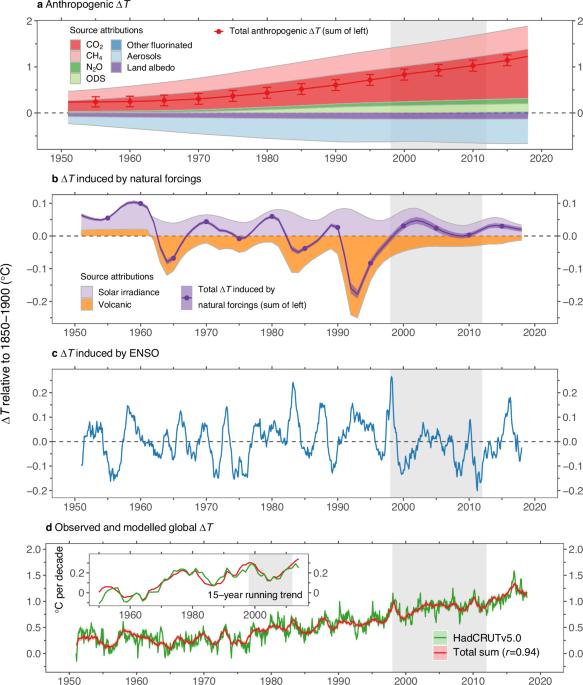大气中非二氧化碳温室气体含量的减少可解释 1998-2012 年变暖减缓的四分之一原因
IF 8.1
1区 地球科学
Q1 ENVIRONMENTAL SCIENCES
引用次数: 0
摘要
从 1998 年到 2012 年,观测到的全球平均地表温度上升速度慢于 1951 年以来的上升速度。然而,包括气候致变因素在内的所有相关因素的相对贡献尚未得到全面分析。通过使用复杂度降低的气候模式和观测约束统计模式,我们发现,与1951-2012年相比,拉尼娜现象的降温和太阳周期的下降分别导致1998-2012年总升温速度减慢约50%和26%。此外,臭氧消耗物质和甲烷的减少约占变暖减缓总量的四分之一,这可以用大气浓度的变化来解释。我们发现,1998-2012 年期间,非二氧化碳温室气体在减缓全球变暖方面发挥了重要作用。根据使用复杂度降低的气候模型进行的分析,拉尼娜现象的降温和太阳周期的下降共同解释了1998年至2012年间约四分之三的变暖减缓,而大气中甲烷和臭氧消耗物质含量的变化解释了其余四分之一的变暖减缓。本文章由计算机程序翻译,如有差异,请以英文原文为准。

Reductions in atmospheric levels of non-CO2 greenhouse gases explain about a quarter of the 1998-2012 warming slowdown
The observed global mean surface temperature increase from 1998 to 2012 was slower than that since 1951. The relative contributions of all relevant factors including climate forcers, however, have not been comprehensively analyzed. Using a reduced-complexity climate model and an observationally constrained statistical model, here we find that La Niña cooling and a descending solar cycle contributed approximately 50% and 26% of the total warming slowdown during 1998-2012 compared to 1951-2012. Furthermore, reduced ozone-depleting substances and methane accounted for roughly a quarter of the total warming slowdown, which can be explained by changes in atmospheric concentrations. We identify that non-CO2 greenhouse gases played an important role in slowing global warming during 1998-2012. Together, La Niña cooling and a descending solar cycle can explain about three quarters of the warming slowdown between 1998 and 2012, whereas changes in the atmospheric levels of methane and ozone depleting substances explain the remaining quarter, according to analyses with a reduced-complexity climate model.
求助全文
通过发布文献求助,成功后即可免费获取论文全文。
去求助
来源期刊

Communications Earth & Environment
Earth and Planetary Sciences-General Earth and Planetary Sciences
CiteScore
8.60
自引率
2.50%
发文量
269
审稿时长
26 weeks
期刊介绍:
Communications Earth & Environment is an open access journal from Nature Portfolio publishing high-quality research, reviews and commentary in all areas of the Earth, environmental and planetary sciences. Research papers published by the journal represent significant advances that bring new insight to a specialized area in Earth science, planetary science or environmental science.
Communications Earth & Environment has a 2-year impact factor of 7.9 (2022 Journal Citation Reports®). Articles published in the journal in 2022 were downloaded 1,412,858 times. Median time from submission to the first editorial decision is 8 days.
 求助内容:
求助内容: 应助结果提醒方式:
应助结果提醒方式:


